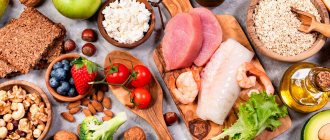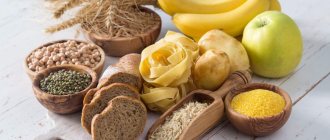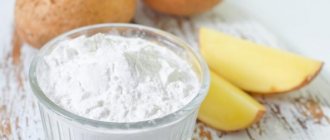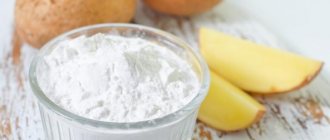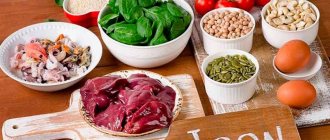Products containing slow carbohydrates: Pixabay Fast and slow carbohydrates, according to world nutritionists, are what modern people who want to lead a healthy lifestyle and eat right should learn to distinguish between. You should be careful with the first ones, but I’ll tell you in detail what slow carbohydrates are and how they are useful.
What are complex carbohydrates and why are they healthy?
Complex carbohydrates are polysaccharides with a long molecular chain. It so happens in nature that complex carbohydrates are the key source of energy. This type of polysaccharides includes starch, glycogen, dietary fiber, pectin and a number of other substances, without which normal biochemical processes are impossible.
Complex carbohydrates contain different structural elements that take time to digest. One of these elements is fiber, which is not digested in the stomach. Water-soluble and water-insoluble plant fibers are important for further absorption. In contrast, simple polysaccharides are digested very quickly, without much effort for the body.
The main characteristic that determines the benefits of complex carbohydrates is the glycemic index. For the nutrition of a healthy person and especially a person with diabetes, it is important that the calories contained in food are absorbed gradually. Slow processes of polysaccharide breakdown do not provoke surges in blood glucose. It is recommended for overweight people to consume foods that include complex carbohydrates, since obesity is accompanied by a disorder of insulin synthesis.
A sharp change in blood sugar levels causes a feeling of hunger and stimulates appetite. The introduction of complex carbohydrates into the diet is recommended for people who follow the rules of a healthy lifestyle, diabetics and simply anyone who wants to normalize their metabolism and ensure a normal weight.
It has been proven that plant fibers have probiotic properties, i.e. they stimulate the growth and spread of beneficial intestinal microflora. A healthy intestine fully digests food, provides high immune protection, and controls cholesterol in the blood. Fast, simple carbohydrates do not have these properties, but, on the contrary, suppress intestinal function.
Types of complex carbohydrates
The classification of complex carbohydrates depends on the glycemic index. The following types are distinguished:
- Glycogen - includes glucose molecules connected in a special chain. Maintains a stable concentration of sugar in the blood, promotes the restoration of muscle mass. Glycogen is found in animal products (red meat, beef heart, liver), fish.
- Pectin is a sticky substance that is essentially a derivative of galacturonic acid. The peculiar structure does not allow carbohydrates to be absorbed, but gives it adsorbing properties. Pectin perfectly absorbs toxins, putrefactive bacteria, pathogens and completely removes them from the body. These qualities provide protection for the mucous membrane of the gastrointestinal tract from mechanical damage and chemical influences.
- Starch is an insoluble plant fiber that ensures a uniform release of energy and long-term satiety after eating. The complex polysaccharide slows down the rise in glucose and blocks insulin surges, thus protecting the pancreas from destructive stress. Thanks to starch, normal metabolism is maintained and the body's defenses are increased. The best sources of starch are oatmeal, brown rice, lentils, pasta, buckwheat, rye bread, potatoes, legumes (soybeans, peas, lentils).
- Fiber is a plant fiber that works like a brush that “cleans out” excess cholesterol. Thanks to fiber, bile flow improves and intestinal function is normalized. The main sources of fiber are berries, seeds and nuts, fruit and vegetable peels, oats, buckwheat, citrus fruits, cabbage, apples, wholemeal flour.
Symptoms of high insulin
So, say, frequent consumption of high-carbohydrate foods (be it a full breakfast and lunch, yogurt instead of a snack, nuts and even one candy), the pancreas will react by synthesizing and releasing insulin.
Its constant circulation in the blood leads to a decrease in the sensitivity of cell receptors - they are capricious and no longer want to open their doors, letting in glucose. Insulin resistance develops
- the first step in the pathogenesis of type 2 diabetes mellitus.
We recommend
“Insulin resistance: prevention, nutrition and treatment” Read more
However, cells also do not like to go hungry: since glucose does not come to them from the outside, they begin to synthesize it themselves, inside their cytoplasm - gluconeogenesis is a process in which inside the cell itself from various non-carbohydrate compounds (for example, keto acids) comes to the rescue. Glucose is formed through a series of biochemical reactions.
You can suspect signs of insulin resistance based on the presence of the following symptoms:
- The appearance of papillomas
are benign tumors on the skin that occur due to excessive cell division. (The whole point is that insulin is an anabolic (synthesis) hormone. Athletes often sin by resorting to its injections: everything is for the growth of muscle mass. However, not only it, as we see, grows under its influence).
- Constant feeling of hunger
- glucose simply does not pass through the closed gates of the cells, and they, knocking on tambourines, begin to sound the alarm.
- Waist
more than 80 cm for women and more than 90 cm for men.
- Body mass index
>24 (excess weight is a sure companion of impaired carbohydrate metabolism).
- Blackening of the skin
on the elbows, armpits, groin and neck (acanthosis nigricans).
- Capillary angiomas
(red dots on the body).
- Hirsutism
(excessive hair growth); acne, alopecia (hair loss), anovulation and other signs of hyperandrogenism (increased levels of male sex hormones in the blood).
The reason for this is that the ovaries are stimulated directly by insulin or in combination with LH (luteinizing hormone) - and they begin to produce more androgens.
- Increased blood pressure and swelling
(insulin retains sodium, which pulls water with its tail - an increase in the volume of circulating blood occurs).
- Bacterial and fungal overgrowth syndrome
: Glucose is a favorite treat of many pathogenic organisms.
- Increased cholesterol
and stimulation of the growth of atherosclerotic plaques.
- Reduced bile fluidity
— its stagnation (cholestasis) develops.
- Geeking
(sugarification) of collagen and the appearance of wrinkles
- Damage to the vascular endothelium
. Thus, patients suffering from type 2 diabetes are much more at risk of developing stroke and heart attack - these diseases of the cardiovascular system account for more than 75% of all causes of mortality.
The negative impact of increased glucose levels on the endothelium (internal lining) of blood vessels comes down mainly to two of its effects:
- Increased sorbitol formation
(an alcohol synthesized during its biochemical transformations) and its accumulation in cells - here it causes a decrease in the level of myoinositol (an important transmitter (messenger) of intracellular signals) and also leads to osmotic damage.
- Formation of AGE products
(advanced glycation end-products or advanced glycation end products) - these three letters describe one of the most popular and scientifically proven theories of aging. Glucose, interacting with the amino acids of proteins, leads to their “sugarification”. The complexes formed in this way accumulate in cells and tissues, leading to their further damage.
In general, in the pathogenesis of the development of endothelial dysfunction, an important role is played by an imbalance between factors leading to vasodilation (vasodilatation), vasoconstriction (narrowing of the lumens of blood vessels), anti- and prothrombotic factors (in other words, anticoagulants and components of the blood coagulation system).
Nitric oxide
(NO) - one of the most powerful and important vasodilators - is formed during the biochemical conversion of the amino acid arginine to citrulline. Various pathological conditions, such as hyperglycemia (increased serum glucose levels), as previously noted, trigger increased work in the free radical production factory.
Reactive oxygen species (for example, superoxide anion) react with NO, forming a dangerous, powerful oxidizing agent - peroxynitrite, which destabilizes and causes various kinds of disturbances in the structure and operation of NO synthase (an enzyme that directly catalyzes the synthesis of nitric oxide, and also takes part in the formation neurotransmitters: serotonin, dopamine, etc.)
Study
: Antidiabetic Agents and Endothelial Dysfunction – Beyond Glucose Control
Are all complex carbohydrates digested slowly?
When switching to a diet that predominantly contains complex carbohydrates, it is important to understand that not all of them are equally beneficial. If we talk about starch, then in wheat and white rice it has an equally complex molecular structure, but is unable to quickly digest and absorb in the gastrointestinal tract.
Many carbohydrate foods contain maltodextrin, a complex polysaccharide consisting of long molecular chains. Despite its complex structure, it acts in the gastrointestinal tract like a regular carbohydrate and is quickly absorbed.
The most complex products are pasta made from wheat. The rate of absorption is affected by the type of wheat, the method of preparation, and the portion that a person uses as a side dish. Depending on these parameters, pasta has a high, medium or low glycemic index. When high, they have the properties of simple (fast) carbohydrates, and when low, they have the properties of carbohydrates with complex (long-term) absorption.
The complexity of a carbohydrate depends on its fiber concentration. If a food product contains a lot of plant fiber, it is said to be beneficial. For example, potatoes, which are classified as carbohydrate foods, have very little fiber, but a lot of starch. Knowing this feature, you should correctly calculate the optimal portion. Beans are a healthier carbohydrate product - per 100 g of dry beans there are 60 g of complex polysaccharides, 1/4 of which is fiber.
Not banned, but under suspicion
Numerous popular diets have developed in most of us a disdainful and even sharply negative attitude towards carbohydrate-containing foods.
There are methods that are based on the consumption of foods low in sugars, and there are those in which they are completely prohibited because they cause a sharp increase in body weight. But is this really so and why can’t we completely give up bread, corn, legumes, and sweet fruits, if we believe the statement that they are so harmful? In order to tell which foods are those that contain simple and complex carbohydrates, we must explain the nature of the compounds themselves, which nutritionists are afraid of.
So, we have before us organic substances that have a number of properties:
- Perform energetic and structural functions.
- They are part of complex proteins.
- They cannot be synthesized by the body - we get them exclusively from food.
Products related to essential sources of carbohydrates, a list of which we will give later, are divided into those that contain lighter and more complex compounds. We will tell you more about them below.
Which foods contain the most complex carbohydrates?
The classification of carbohydrates into simple and complex, based solely on differences in structure, is not entirely correct. It is more correct to divide polysaccharides according to the glycemic index - the ability of the product to be converted into glucose. The glycemic index (GI) in foods varies from 0 to 100. A high GI indicates rapid absorption of foods, a low GI indicates slow absorption.
The concept of GI was formed when measuring blood sugar levels in the morning after eating a product on an empty stomach.
Based on the data obtained, they distinguish:
- Low GI - less than 55.
- The average GI is 55-69.
- High - more than 70.
It is important to remember that the glycemic index is considered together with the glycemic load. Glycemic load (GL) is calculated based on the carbohydrate content of the product.
GN can be:
- Low - less than 10.
- Average - from 10 to 19.
- High – more than 20.
The optimal combination of these indicators determines the benefits of a high-carbohydrate product.
TOP 10 best foods with the highest content of complex carbohydrates
| Photo | Product: | Kcal: | Carbohydrates (per 100 g) | GI |
| Soybeans | 364 Kcal | 30.2 g | 15 | |
| Black beans | 341 Kcal | 46.9 g | 20 | |
| Lentils | 353 Kcal | 60 g | 25 | |
| Chickpeas | 378 Kcal | 62.9 g | 30 | |
| Wild rice | 357 Kcal | 74.9 g | 35 | |
| Wholemeal bread | 252 Kcal | 42.7 g | 35 | |
| Durum wheat pasta | 352 Kcal | 73.4 g | 40 | |
| Oats | 389 Kcal | 66.1 g | 40 | |
| Buckwheat | 343 Kcal | 70 g | 40 | |
| Green peas (canned) | 81 Kcal | 14.45 g | 48 | |
| Brown rice (unpolished) | 362 Kcal | 76.2 g | 50 |
View the entire table of carbohydrates 350+ ➤
10 more popular foods with long-term absorption:
- Oatmeal - digestion time up to 4 hours, GI - 66.
- Boiled rice - digestible in up to 3 hours, GI - 65.
- Boiled potatoes - digestion takes from 2 to 3 hours, depending on the variety, GI - 65.
- Beets - digestible in 3 hours, GI - 65.
- Raisins - digestible within 2 hours, GI - 65.
- Rye bread - digestion from 3 to 3.5 hours, GI - 65.
- Pearl barley - digestible within 1.5 hours, GI - 22.
- Bananas - digested in 1 hour, GI - 60.
- Cabbage - digestible in up to 4 hours, GI - 10.
- Processed cheese - digestion for 3 hours, GI - 56.
[Video] Best sources of complex carbohydrates:
Vegetables are record holders
| Photo | Product: | Kcal: | Carbohydrates (per 100 g) | GI |
| Broccoli | 34 Kcal | 6.6 g | 10 | |
| Cabbage | 28 Kcal | 6 g | 15 | |
| Artichoke | 53 Kcal | 12 g | 20 | |
| Beet | 40 Kcal | 11.3 g | 54 | |
| Potatoes (boiled) | 77 Kcal | 19.6 g | 65 |
It should be noted that if potatoes are fried or mashed, the GI will jump to 95. In addition, the calorie content will increase: fried - 184 KCal, fried - 266 KCal, chips - 538 KCal, mashed potatoes - 92 KCal.
Fruits and berries are record holders
| Photo | Product: | Kcal: | Carbohydrates (per 100 g) | GI |
| Grapefruit | 33 Kcal | 8.4 g | 22 | |
| Prunes | 256 Kcal | 63.9 g | 25 | |
| Dried apricots | 241 Kcal | 62.6 g | 30 | |
| Grape | 64 kcal | 16 g | 40 | |
| Persimmon | 67 Kcal | 16.9 g | 55 | |
| Banana | 89 kcal | 22.8 g | 60 |
Glucose metabolism, its regulation
Ketogenic diet
- low-carbohydrate diet (about 50 grams) high in fat.
So, to the list of “ prohibited”
» products include:
- Fruits
- Cereals
- Bakery and confectionery products
- Honey
- Starchy vegetables
- Juices, lemonades, alcoholic drinks
- Trans fats
- Oils high in omega-6 polyunsaturated fatty acids: sunflower oil, as well as palm, cottonseed, and rapeseed.
- Low-fat dairy products
- Ready sauces
- Energetic drinks
Despite the rather impressive red list of taboos, the low-carb diet is nevertheless quite varied and includes fresh berries, meat, dairy products, fish and seafood, nuts and seeds, vegetables, herbs, and vegetable oils.
We recommend
“Common types of diets in nutritionology and their descriptions” Read more
Most of the usual, traditional dishes can also be easily prepared, taking into account the rules and carbohydrate limits of the keto diet - you just need to show a little imagination and slightly change the established focus of vision.
Low-carbohydrate diets, due to their high fat consumption, make it easy to stick to a 2-3 meals a day diet, avoiding annoying thoughts about snacking. In addition, they can easily tolerate intermittent fasting, which is so relevant in the context of treating carbohydrate metabolism disorders.
Beneficial effects of the ketogenic diet:
- Weight loss
and combating metabolic syndrome.
Excessive consumption of carbohydrates, especially sugar, causes the so-called metabolic syndrome, which includes: obesity, type 2 diabetes, cardiovascular disease, lipid problems, inflammation and hypertension. A systematic review of major clinical trials of low-carbohydrate diets found significant weight loss and improvements in major cardiovascular disease risk factors.
- Reducing the frequency of epileptic seizures
- by blocking the receptors of such an excitatory neurotransmitter as glutamate in one of the key structures of the brain - in the hippocampus.
- Treatment of neurodegenerative diseases and disorders
(including depression and Alzheimer's disease).
- Anticonvulsant action
- turns out to be due to the activation of inhibition processes by gamma-aminobutyric acid (GABA), activation of the opioid system of the brain, reducing the effects of excitatory amino acids, the synthesis of nitric oxide (NO) - a powerful vasodilator.
- Changes the composition of bacteria
, inhabiting the intestines.
Thus, a study in which 14 epileptic and 30 healthy children participated showed: in patients with epilepsy after treatment with a ketogenic diet, the number of pathogenic strains of proteobacteria (such as salmonella, vibrio, E. coli) significantly decreased.
Carbohydrates
- vital nutrients that perform a number of important functions in the human body. This is the source of energy, and therefore the existence of our cells.
Their excess has no less adverse effect on the functioning of all systems than their complete absence. From hypoglycemia to diabetes mellitus - going to extremes, it is impossible to achieve the golden mean, those most optimal conditions for a high-quality and healthy life.
Dietary intake of complex carbohydrates for men and women
Calculating the norm of consumption of complex carbohydrates for men and women depends on age, initial weight, daily activity, and most importantly, on the goal.
Norm for women
For women who want to lose weight, the following daily norms of slowly digestible carbohydrates are determined:
- With an initial weight of 50-55 kg - 110 g.
- Weight 60-65 kg - 140 g.
- Weight 70-75 kg - 160 g.
- Initial weight 80-85 kg - 170 g.
To maintain optimal weight, slightly different daily intakes of complex carbohydrates are recommended:
- Weight 50-55 kg - 140 g.
- Weight 60-65 kg - 160 g.
- Weight 70-75 kg - 190 g.
- Weight 80-85 kg - 210 g.
If a woman’s goal is to gain weight, the daily intake of complex carbohydrates should be increased:
- Initial weight 50-55 kg - 190 g.
- Weight 60-65 kg - 240 g.
- Weight 70-75 kg - 250 g.
- Weight 80-85 kg - 260 g.
Norm for men
For men, the daily intake of complex carbohydrates is slightly higher, and they also depend on the goal and initial body weight.
If you want to lose weight, a man is shown the following daily carbohydrate intake:
- Initial weight 50-55 kg - 165 g.
- Weight 60-65 kg - 170 g.
- Weight 70-75 kg - 175 g.
- Weight 80-85 kg - 185 g.
To maintain optimal body weight in men, other daily dosages of complex polysaccharides have been determined:
- Initial weight 50-55 kg - 220 g.
- Weight 60-65 kg - 235 g.
- Weight 70-75 kg - 245 g.
- Weight 80-85 kg - 265 g.
To increase weight, men are recommended to increase the dose of carbohydrates per day:
- Initial weight 50-55 kg - 280 g.
- Weight 60-65 kg - 295 g.
- Weight 70-75 kg - 310 g.
- Weight 80-85 kg - 320 g.
To avoid mistakes, calorie calculations and menu planning taking into account complex carbohydrates should be carried out by a nutritionist based on the initial parameters.
Will complex carbohydrates help you lose weight?
The right selection of complex carbohydrates will help reduce body weight. This is facilitated by the introduction of fruits, vegetables, and whole grains into the daily diet. To get rid of extra pounds, the daily dose of carbohydrates should be from 10 to 15% of the total calorie intake.
The best complex carbohydrates for weight loss, table:
| Cereals | Amaranth, pearl barley, oatmeal, bulgur, millet, unprocessed rice, quinoa, buckwheat, whole grain flour |
| Legumes | Beans, lentils, various types of beans, green peas, chickpeas |
| Nuts, seeds | Sesame, pumpkin, sunflower seeds, flax seeds, poppy seeds, almonds, pine and walnuts, hazelnuts, cashews, pistachios |
| Greenery | Lettuce, spinach, lettuce |
| Vegetables | Carrots, tomatoes, beets, eggplants, zucchini, broccoli, onions, bell peppers, zucchini, celery |
| Fruits | Citrus fruits, apples, pears, peaches, avocado, pomegranate, figs |
| Berries | Raspberries, cherries, strawberries, currants, plums, cranberries, prunes, sweet cherries, gooseberries |
[Video] How to eat carbohydrates and lose weight:
Complex carbohydrates for muscle gain
Carbohydrates do not easily provide a person with energy; they prevent the destruction of muscle tissue. With a deficiency of polysaccharides, the body begins to break down muscle fiber cells to obtain the required amount of energy. Products containing carbohydrates should become an obligatory part of the diet of athletes and people of heavy physical labor. Thanks to them, the body compensates for the loss of spent glycogen.
A lack of carbohydrates in food is manifested by fatigue, a decrease in strength indicators, which means that there can be no talk of any muscle relief or body sculpture. Carbohydrates combined with sufficient protein create healthy muscles.
To get the desired muscle volume, you should correctly calculate the amount of carbohydrates. To achieve maximum effect, their volume should be more than 30% of all calories entering the body.
You can supply yourself with healthy carbohydrates using certain foods:
- Brown Uncooked Rice - Combines the right carbohydrates with other nutrients, helps build muscle mass, promotes satiety, and maintains normal blood sugar levels. White, polished rice does not have similar properties.
- Oats provide the body not only with complex carbohydrates, but also with protein, guarantee an increase in muscle fibers, activate digestion, alleviate the symptoms of inflammation, and nourish healthy intestinal microflora.
- Sweet potatoes are a source of vitamins, microelements, fiber, and natural sugars. Useful for nourishing the brain, strengthening the immune system and providing energy.
More details:
Diet for gaining muscle mass for men
Lactose
Lactose, called “milk sugar,” is a disaccharide that is broken down by the lactase enzyme in the intestine into glucose and galactose, which are absorbed by the body. This carbohydrate is found in milk and dairy products.
Benefits of lactose:
- providing the body with energy;
- facilitating calcium absorption;
- normalization of intestinal microflora due to the development of beneficial lactobacilli;
- stimulation of nervous regulation processes;
- prevention of the development of cardiovascular diseases.
Harm from lactose
This carbohydrate can cause harm when the human body lacks (or is present in insufficient quantities) the lactase enzyme, which promotes the digestibility of lactose. Lactase deficiency provokes milk intolerance and contributes to intestinal disorders.
Important!
If you are lactose intolerant, it is recommended to consume fermented milk products, in which most of this carbohydrate is fermented to lactic acid, which is well absorbed by the body.
Interesting fact!
Pure lactose is used in the production of various food products, dietary supplements and medicines aimed at preventing and treating dysbiosis.
What foods contain lactose?
As mentioned above, milk and dairy products are most enriched with lactose, containing up to 8 percent of this carbohydrate per 100 ml of product.
In addition, lactose is present in the following foods that everyone loves:
- bread;
- products for diabetics;
- confectionery;
- powdered milk;
- whey and related by-products;
- condensed milk;
- margarine;
- ice cream;
- coffee cream (both dry and liquid);
- sauces and salad dressings (ketchup, mustard, mayonnaise);
- cocoa powder;
- flavor enhancers.
Lactose is not contained in the following products:
- coffee;
- fish;
- tea;
- soybean and its by-products;
- fruits;
- vegetables;
- eggs;
- nuts;
- vegetable oils;
- legumes and grains;
- meat.
What does carbohydrate deficiency lead to?
You won't be able to stock up on complex carbohydrates for future use. Physical activity and intellectual work contribute to the absorption of polysaccharides. To maintain normal functions, the body needs a sufficient amount of carbohydrate foods.
Complex carbohydrates should make up the bulk of your daily diet. Their optimal daily volume for a healthy person should be from 55 to 75% of the total amount of food. No more than 10% of this amount should be simple (fast) carbohydrates. To maintain normal weight, the daily diet of an adult requires the presence of 20-25 g of fiber.
In case of a lack of carbohydrates, the body launches compensation mechanisms. To obtain the necessary energy, one begins to consume one's own proteins and fats, rather than those coming from outside. Protein breakdown provokes the destruction of muscle fibers and a slowdown in metabolism. Consumption of fat to provide energy to the body leads to the formation of ketone bodies and subsequent intoxication. A person feels a deficiency of carbohydrates physically, as constant fatigue, drowsiness, while absent-mindedness and impaired concentration appear.
Complex carbohydrates provide healthy energy. A healthy diet should include foods rich in plant fiber (cereals, vegetables, whole grain bread, fruits).
Sucrose (sugar)
Sucrose is a well-known white sugar that is called an “empty carbohydrate” because it does not contain nutrients such as vitamins and minerals.
Today, discussions continue regarding the benefits and harms of this disaccharide. Let's try to understand this issue.
The benefits of sugar
- Ensuring normal brain function.
- Increased performance.
- Uplifting mood, which is important in modern life full of stress.
- Providing the body with energy (sugar is quickly broken down in the gastrointestinal tract into glucose and fructose, which are absorbed into the blood).
In turn, a deficiency of sugar in the body can cause irritation, dizziness and severe headaches.
The harm of sugar
- Metabolic disorders, which leads to the development of obesity and diabetes.
- Destruction of tooth enamel.
- Displacement of B vitamins from the blood, which can provoke sclerosis, heart attack and vascular diseases.
- Disruption of the musculoskeletal system.
- Brittle hair and nails.
- The appearance of acne and allergic rashes.
In addition, excessive love for sweets in children often develops into neuroses and causes hyperactivity.
What to do? Quit sugar completely? But the benefits of this carbohydrate are undeniable. There is a way out - and this is moderation in the use of this product.
During the research, the optimal daily intake of sugar was determined, which for an adult was 50–60 g, which corresponds to 10 teaspoons.
BUT!
The “norm” refers to both pure sugar and sugar contained in vegetables, fruits, juices, confectionery and other products that contain this carbohydrate. Therefore, you should consume sugar responsibly and carefully.
Important!
There is an alternative to white sugar - and this is brown sugar, which does not undergo any additional purification after separation from the raw materials (such sugar is also called unrefined). The calorie content of brown sugar is lower, while the biological value is higher. However, we should not forget that the difference between refined and unrefined sugar is not very large, so the consumption of both types should be moderate.
What foods contain sucrose?
Natural sources of sucrose in its pure form are sugar beets and sugar cane.
In addition, sucrose is present in sweet fruits, fruits, as well as berries and vegetables.


